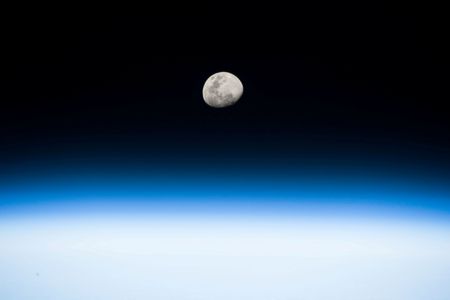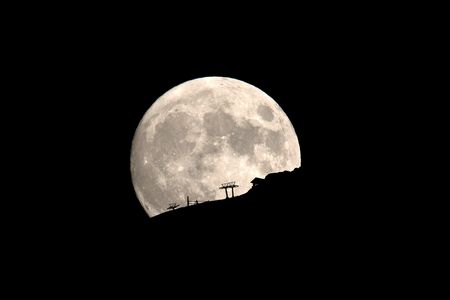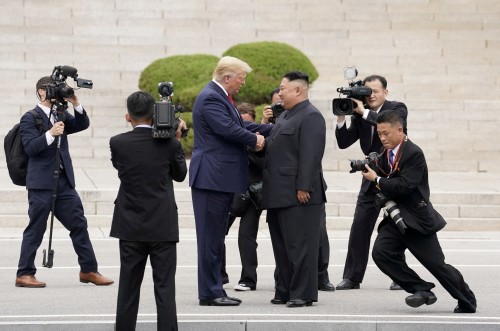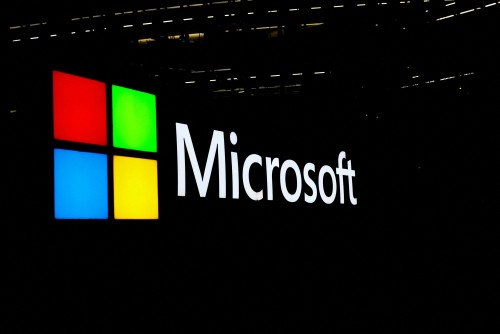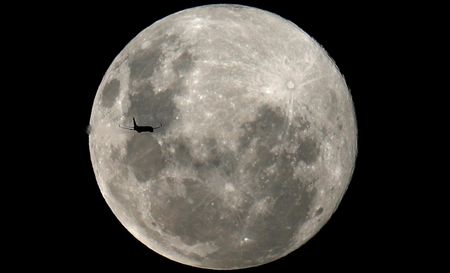
A plane is pictured in front of the full moon in Curitiba
By Joey Roulette and Will Dunham
WASHINGTON (Reuters) – The White House on Tuesday directed NASA to establish a unified standard of time for the moon and other celestial bodies, as the United States aims to set international norms in space amid a growing lunar race among nations and private companies.
The head of the White House Office of Science and Technology Policy (OSTP), according to a memo seen by Reuters, instructed the space agency to work with other parts of the U.S. government to devise a plan by the end of 2026 for setting what it called a Coordinated Lunar Time (LTC).
The differing gravitational force, and potentially other factors, on the moon and on other celestial bodies change how time unfolds relative to how it is perceived on Earth. Among other things, the LTC would provide a time-keeping benchmark for lunar spacecraft and satellites that require extreme precision for their missions.
“The same clock that we have on Earth would move at a different rate on the moon,” Kevin Coggins, NASA’s space communications and navigation chief, said in an interview.
OSTP chief Arati Prabhakar’s memo said that for a person on the moon, an Earth-based clock would appear to lose on average 58.7 microseconds per Earth-day and come with other periodic variations that would further drift moon time from Earth time.
“Think of the atomic clocks at the U.S. Naval Observatory (in Washington). They’re the heartbeat of the nation, synchronizing everything. You’re going to want a heartbeat on the moon,” Coggins said.
Under its Artemis program, NASA is aiming to send astronaut missions to the moon in the coming years and establish a scientific lunar base that could help set the stage for future missions to Mars. Dozens of companies, spacecraft and countries are involved in the effort.
An OSTP official said that without a unified lunar time standard it would be challenging to ensure that data transfers between spacecraft are secure and that communications between Earth, lunar satellites, bases and astronauts are synchronized.
Discrepancies in time also could lead to errors in mapping and locating positions on or orbiting the moon, the official said.
‘HOW DISRUPTIVE’
“Imagine if the world wasn’t syncing their clocks to the same time – how disruptive that might be and how challenging everyday things become,” the official said.
On Earth, most clocks and time zones are based on Coordinated Universal Time, or UTC. This internationally recognized standard relies on a vast global network of atomic clocks placed in different locations around the world. They measure changes in the state of atoms and generate an average that ultimately makes up a precise time.
Deployment of atomic clocks on the lunar surface may be needed, according to the OSTP official.
The official also said that as commercial activities expand to the moon, a unified time standard would be essential for coordinating operations, ensuring the reliability of transactions and managing the logistics of lunar commerce.
NASA in January said it has scheduled for September 2026 its first astronaut lunar landing since the end of the Apollo program in the 1970s, with a mission flying four astronauts around the moon and back scheduled for September 2025.
While the United States is the only country to have put astronauts on the moon, others have lunar ambitions. Countries have their eyes on potential mineral resources on the moon, and lunar bases could help support future crewed missions to Mars and elsewhere.
China said last year it aims to put its first astronauts on the moon by 2030. Japan in January became the fifth country to put a spacecraft on the moon. India last year became the first country to land a spacecraft near the unexplored lunar south pole, and it has announced plans to send an astronaut to the moon by 2040.
“U.S. leadership in defining a suitable standard – one that achieves the accuracy and resilience required for operating in the challenging lunar environment – will benefit all spacefaring nations,” the OSTP memo stated.
Defining how to implement Coordinated Lunar Time will require international agreements, the memo said, through “existing standards bodies” and among the 36 nations that have signed a pact called the Artemis Accords involving how countries act in space and on the moon. China and Russia, the two main U.S. rivals in space, have not signed the Artemis Accords.
Coordinated Universal Time might influence how Coordinated Lunar Time is implemented, the OSTP official said. The U.N.’s International Telecommunication Union defines Coordinated Universal Time as an international standard.
his story has been refiled to correct an abbreviation error in paragraph 11)
(Reporting by Joey Roulette and Will Dunham, Editing by Rosalba O’Brien)

